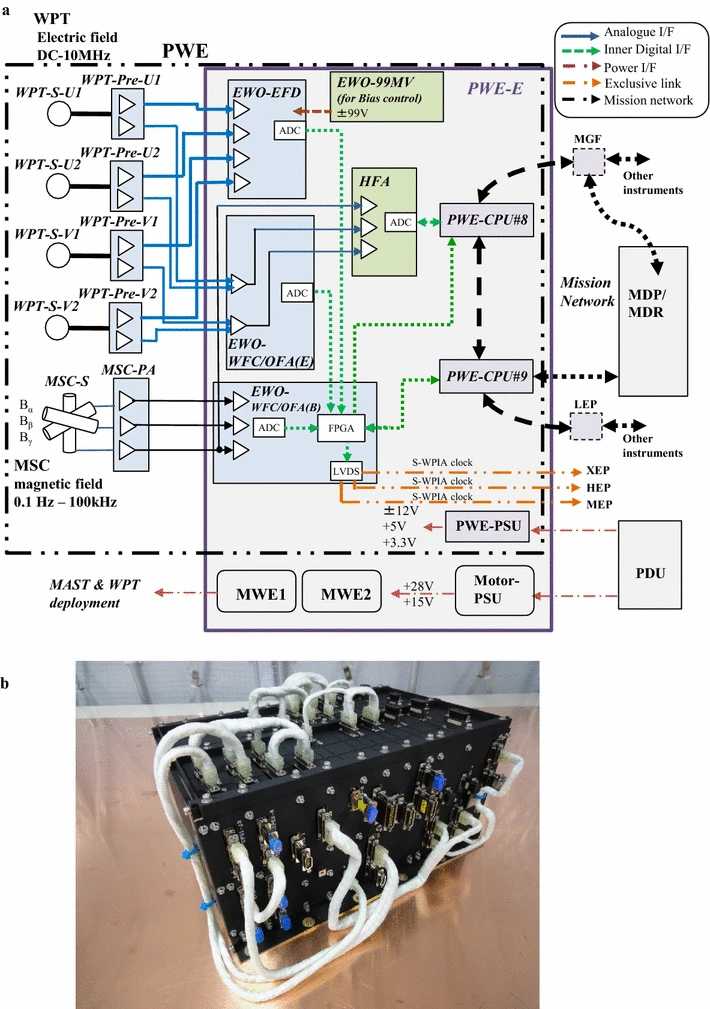Plasma Wave Experiment, PWE

Members
- PI
- Yoshiya Kasahara (Kanazawa University)
- Co-PI
- Yasumasa Kasaba (Tohoku University)
- Hirotsugu Kojima (Kyoto University)
- Satoshi Yagitani (Kanazawa University)
- Co-I
- Keigo Ishisaka (Toyama Prefectural University)
- Atsushi Kumamoto (Tohoku University)
- Fuminori Tsuchiya (Tohoku University)
- Mitsunori Ozaki (Kanazawa University)
- Tomohiko Imachi (Kanazawa University)
- Yoshizumi Miyoshi (Nagoya University)
- Shoya Matsuda (JAXA/ISAS)
- Satoshi Kurita (Kyoto University)
- Tomoko Nakagawa (Tohoku Institute of Technology)
- Mitsuru Hikishima (JAXA/ISAS)
- Yuto Katoh (Tohoku University)
- Hiroaki Misawa (Tohoku University)
- Tomoki Kimura (Tohoku University)
Instrument Specifications and Measured Quantities
PWE Overall
Kasahara, Y., Y. Kasaba, H. Kojima, S. Yagitani, K. Ishisaka, A. Kumamoto, F. Tsuchiya, M. Ozaki, S. Matsuda, T. Imachi, Y. Miyoshi, M. Hikishima, Y. Katoh, M. Ota, M. Shoji, A. Matsuoka, and I. Shinohara, The Plasma Wave Experiment (PWE) on board the Arase (ERG) satellite, Earth, Planets and Space, doi:10.1186/s40623-018-0842-4, 2018.Magnetic Field Sensor
Developed by NIPPI Corporation and Kanazawa University.
- MSC (Magnetic Search Coils)
Magnetic field 1 Hz to 100 kHz, 3 axes (Bα, Bβ, Bγ)
Electric Field Sensor
Developed by NIPPI Corporation and Tohoku University.
- WPT (Wire-Probe Antenna): 4 fifteen-m wire antennas
Electric field DC to 10 MHz, 2 axes (EU, EV)
Low-Frequency Wave Receiver: EWO (EFD/OFA/WFC)
Developed by MItsubishi Heavy Industries, and Kyoto University, Kanazawa University, Tohoku University, and Toyama Prefectural University.
- EFD (Electric Field Detector)
DC to 200 Hz (electric field wave form and spectrum) - EFD-DPB (Double Probe)
wave form (64 Hz (Apo[apogee]-mode) or 256 Hz(Peri[perigee]-mode)
spectrum (f=1-224 Hz) - EFD-SPB (Single Probe)
wave form (8 Hz) - EFD Burst
EFD-DPB (512 Hz) and EFD-SPB (128 Hz) are continuously or intermittently measured.
-
OFA (Onboard Frequency Analyzer)
10 Hz to 20 kHz (electric field spectrum)
1 Hz to 20 kHz (magnetic field spectrum) - OFA-SPEC: power spectrum (selected from the following 4 modes)
Δt=0.5 s (# of frequency: 66 pts)
Δt=1 s (# of frequency: 132 pts)
Δt=2 s (# of frequency: 264 pts)
Δt=4 s (# of frequency: 528 pts) - OFA-MATRIX: spectral-matrix
Interlocked with OFA-SPEC. The time resolution is reduced to 1/8.
(Δt=4 s if Δt=0.5 s for OFA-SPEC. The same frequency resolution.) - OFA-COMPLEX: real and imaginary parts of instantaneous spectrum
The same time and frequency resolutions as OFA-MATRIX.
-
WFC (Waveform Capture)
10 Hz to 20 kHz (electric field wave form)
1 Hz to 20 kHz (magnetic field wave form) - Chorus Burst: 65,536 Hz, 5 electric and magnetic field components, intermittently measured (8 s/shot (nominal))
- EMIC Burst: 1,024 Hz, 5 electric and magnetic field components, intermittently measured (3 min/shot (nominal))
High-Frequency Wave Receiver: HFA
Developed by Meisei Electric and Tohoku University.
- HFA (High Frequency Analyzer)
10 kHz to 10 MHz (electric field spectrum, # of frequency: 480 pts, Δf/f <2.5%)
10 kHz to 100 kHz (magnetic field spectrum, # of frequency: 160 pts, Δf/f <2.5%) - EE-mode (2 electric field components, Δt=8 s (nominal) or 1 s, 2 s, 16 s (optional))
- LR-mode (2 electric field components, Δt=8 s (nominal) or 1 s (optional))
- EB-mode (1 electric field component + 1 magnetic field component, Δt=8 s (nominal) or 1 s (optional))
- Plasmapause mode (1 electric field component, Δt=1 s (nominal))
- wave form output mode (event-trigger method, 0.082 ms duration (25 Msps) and 0.82 ms duration (2.5 Msps))
- high frequency resolution mode (Δf=1.2 kHz (
<1 MHz) or Δf=12 kHz (>1 MHz))
The band width, number of channels, and time resolution depend on setting.
Link
- Wiki
-
DOI: 10.34515/DATA.ERG-07000 (Lv.2 spin-fit electric field data)
DOI: 10.34515/DATA.ERG-07001 (Lv.2 spin-averaged potential data)
DOI: 10.34515/DATA.ERG-07004 (Lv.2 electric field spectrum data)
DOI: 10.34515/DATA.ERG-08000 (Lv.2 spectrum data)
DOI: 10.34515/DATA.ERG-10000 (Lv.2 spectrum data) - CDF file
